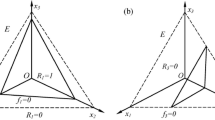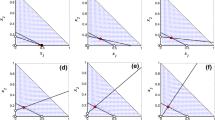Abstract
Mixotrophy is ubiquitous in microbial communities of aquatic systems with many flagellates being able to use autotroph as well as heterotroph pathways for energy acquisition. The usage of one over the other pathway is associated with resource availability and the coupling of alternative pathways has strong implications for system stability. We investigated the impact of dominance of different energy pathways related to relative resource availability on system dynamics in the setting of a tritrophic food web motif. This motif consists of a mixotroph feeding on a purely autotroph species while competing for a shared resource. In addition, the autotroph can use an additional exclusive food source. By changing the relative abundance of shared vs. exclusive food source, we shift the food web motif from an intraguild predation motif to a food chain motif. We analyzed the dependence of system dynamics on absolute and relative resource availability. In general, the system exhibits a transition from stable to oscillatory dynamics with increasing nutrient availability. However, this transition occurs at a much lower nutrient level for the food chain in comparison to the intraguild predation motif. A similar transition is also observed with variations in the relative abundance of food sources for a range of nutrient levels. We expect this shift in food web motifs to occur frequently in microbial communities and therefore the results from our study are highly relevant for natural systems.
Similar content being viewed by others
References
A. Pikovsky, M. Rosenblum, J. Kurths, Synchronization: A Universal Concept in Nonlinear Sciences (Cambridge University Press, 2001)
K. Bar-Eli, J. Phys. Chem. 88, 3616 (1984)
U. Feudel, Int. J. Bifurc. Chaos 18, 1607 (2008)
G. Ansmann, R. Karnatak, K. Lehnertz, U. Feudel, Phys. Rev. E 88, 052911 (2013)
R. Albert, A.-L. Barabási, Phys. Rev. E 88, 052911 (2013)
I. Farkas, I. Derényi, H. Jeong, Z.Nédac, Z.N. Oltvai, E. Ravaszc, A. Schubert, A.-L Barabási, T. Vicsek, Physica A 314, 25 (2002)
G. Palla, A.-L. Barabási, T. Vicsek, Nature 446, 664 (2007)
M.E.J. Newman, Networks: An Introduction (Oxford University Press, 2010)
S. Bornholdt, H.G. Schuster (Eds.) Handbook of Graphs and Networks: From the Genome to the Internet (John Wiley & Sons, 2003)
R. Albert, A.-L. Barabási, T. Vicsek, Rev. Mod. Phys. 74, 47 (2002)
A. Masoudi-Nejad, F. Schreiber, Z.R.M. Kashani, IET Syst. Biol. 6, 164 (2012)
R.M. May, Ecology 67, 1115 (1986)
S.L. Pimm, J.H. Lawton, J.E. Cohen, Nature 250, 669 (1991)
S.A. Levin, Ecology 73, 1943 (1992)
S.H. Strogatz, Nature 410, 268 (2001)
J.A. Dunne, R.J. Williams, N.D. Martinez, Proc. Natl. Acad. Sci. 99, 12917 (2002)
S.L. Pimm, J.H. Lawton, Nature 275, 542 (1978)
R.D. Holt, G.A. Polis, Am. Naturalist 149, 745 (1997)
K. McCann, A. Hastings, Proc. Biol. Sci. 264, 1249 (1997)
R. Karnatak, R. Ramaswamy, U. Feudel, Chaos, Solitons Fractals 68, 48 (2014)
S. Rinaldi, O. De Feo, Ecol. Lett. 2, 6 (1999)
P.V. Paulau, C. Feenders, B. Blasius, Sci. Rep. 5, 11926 (2015)
B. Baiser, R. Elhesha, T. Kahveci, Oikos 125, 480 (2016)
G.A. Polis, C.A. Myers, R.D. Holt, Annu. Rev. Ecol. Syst. 20, 1 (1989)
A.C. Hammer, J.W. Pitchford, ICES J. Mar. Sci. 62, 833 (2005)
J.M. Burkholder, P.M. Glibert, H.M. Skelton, Harmful Algae 8, 77 (2008)
S. Wilken, J.M.H. Verspagen, S.N.-Wiezer, E. Van Donk, J. Huisman, Oikos 123, 423 (2014)
C.S. Holling, The Canada Entomologist 91, 293 (1959)
C.S. Holling, The Canada Entomologist 91, 385 (1959)
G.D. Byrne, S. Thompson, http://www.radford.edu/thompson/vodef90web/index.html (2013 version)
P.N. Brown, G.D. Byrne, A.C. Hindmarsh, SIAM J. Sci. Stat. Comput. 10, 1038 (1989)
M. Rosenzweig, Science 171, 385 (1971)
K. McCann, A. Hastings, G.R. Huxel, Nature 395, 794 (1998)
D. Ritterskamp, C. Feenders, D. Bearup, B. Blasius, Theor. Ecol. 9, 501 (2016)
S. Diehl, M. Feissel, Am. Naturalist 155, 200 (2000)
R.W. Sanders, J. Protozoology 38, 76 (1991)
R.I. Jones, Freshwater Biol. 45, 219 (2000)
B.A. Ward, M.J. Follows, Proc. Natl. Acad. Sci. 113, 2958 (2016)
S. Wilken, J. Huisman, S.N.-Wiezer, E. Van, Donk, Ecol. Lett. 16, 225 (2013)
N.N. Rabalais, R.E. Turner, R.J. Diaz, D. Justić, J. Mar. Sci. 66, 1528 (2009)
D.M. Andreson, P.M. Gilbert, J.M. Burkholder, Estuaries 25, 704 (2002)
C.E Williamson, W. Dodds, T.K. Kratz, M.A. Palmer, Front. Ecol. Environ. 6, 247 (2008)
F.R. Vasconcelos, S. Diehl, P. Rodríguez, P. Hedström, J. Karlsson, P. Byström, Ecology 97, 2580 (2016)
K.E. Strock, J.E. Saros, S.J. Nelson, S.D. Birkel, J.S. Kahl, W.H. McDowell, Biogeochemistry 127, 353 (2016)
L. Arvola, C. Äijälä, M. Leppäranta, Hydrobiologia 780, 37 (2016)
A.P. Allen, J.F. Gillooly, J.H. Brown, Funct. Ecol. 19, 202 (2005)
Á.L.-Urrutia, E. San Martin, R.P. Harris, X.Irigoien, Proc. Natl. Acad. Sci. 103, 8739 (2006)
C.B. Müller, J. Brodeur, Biol. Control 25, 216 (2002)
D.R. Hart, J. Theor. Biol. 218, 111 (2002)
K.W. Crane, J.P. Grover, J. Theor. Biol. 262, 517 (2010)
Climate change, impacts and vulnerability in Europe 2012, http://www.eea.europa.eu/publications/climate-impacts-and-vulnerability-2012/at_download/file
Author information
Authors and Affiliations
Corresponding authors
Rights and permissions
About this article
Cite this article
Karnatak, R., Wollrab, S. Mixotrophy and intraguild predation – dynamic consequences of shifts between food web motifs. Eur. Phys. J. Spec. Top. 226, 2135–2144 (2017). https://doi.org/10.1140/epjst/e2017-70033-5
Received:
Revised:
Published:
Issue Date:
DOI: https://doi.org/10.1140/epjst/e2017-70033-5




